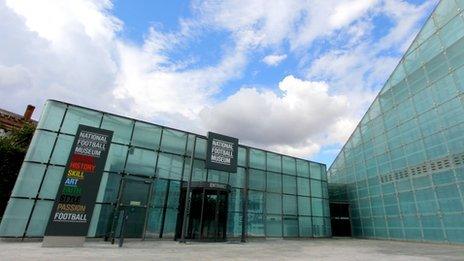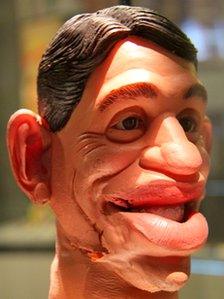National Football Museum opens at new Manchester home
- Published

The National Football Museum occupies the former Urbis building in Manchester, which has undergone an £8m revamp during the two-year project
Pushing through the turnstile at the entrance to the new National Football Museum, the roar of a derby day crowd rings in your ears.
It's the sort of feature that the curators hope will resonate with the thousands of football fans they hope will visit the attraction at its new home in Manchester.
"It could hardly come to the city at a better time than the year Manchester City win the Premier League, with Manchester United coming second."
Coming from England and Blackpool great Jimmy Armfield, it is the sort of endorsement the new National Football Museum requires on the day of its opening.
A shirt donated by the player turned BBC commentator sits alongside items such as the ball from the 1966 World Cup Final and Diego Maradona's Argentina shirt he wore during the infamous 'hand of God' incident.
The museum, which is now housed within the former Urbis building in the city centre, started life at Deepdale, home of Preston North End in Lancashire in 2001.
As winners of the first ever football league title in 1889 and owners of the oldest football league ground still in use, it's obvious to see why Preston was selected as the museum's original home.
However, its eventual move away did not go down well in Lancashire.

A Gary Lineker puppet used for the TV show Spitting Image is on display
In a statement in 2009, Preston North End said they were "shocked and dismayed" at the plans.
Kevin Moore, who founded the National Football Museum in 2001, is now director of its new site.
"We have learned a lot, we are all very proud of what we did in Preston but we've been able to learn and develop and build on that success and what works and how to improve things."
The new site is twice the size of the original, which closed in April 2010.
There are 2,500 items which made the tough selection process to secure a place in the gleaming glass cabinets.
Also on display is the neck brace worn by Manchester City's goalkeeper Bert Trautmann, who played on after breaking his neck during the 1956 FA Cup final between Birmingham and Manchester City.
Although Deepdale may no longer be the public face of the museum, Preston remains the home of the museum's research and collection centre, with more than 140,000 items owned or loaned to the museum.
Jimmy Armfield said he did initially wonder why they were moving the attraction.
He said: "I've got to believe it's a marketing decision, Manchester is a big city, a focal point with an airport and mainline train stations, I presume that's why it's there.
"But wherever it is I just hope it goes well".
'Widest possible audience'
As a charity, donations are crucial to the museum's longevity.
Entrance to the museum is free, but with visitor numbers expected to hit 350,000 a year compared to 100,000 a year in Preston, the potential for donations is high.
According to Visit Manchester, the city's tourist board, more than 100 million people visited the city during 2010.
Mr Moore said the glass wedge-shaped building, which cost £8m to refurbish, was the best place to take the collection "to the widest possible audience".
Many original features of the building remain, with several sections updated to match the new occupants.
The funicular railway, preferred to a lift to suit the building's shape, is now voiced by BBC football commentator John Motson.
Displays detailing events which shook the world are included, including the Valley Parade fire in Bradford, which killed 56 people, and the Hillsborough disaster in Sheffield.
It is this particular day, which saw the loss of 96 lives, which partly inspired photographer Stuart Roy Clarke to start his ongoing 23-year project, The Homes of Football.
He said: "It was a tragedy which made me think all I knew in the sport would now be swept away and there would be a new game, it would still be kicking a ball, but everything else around it could change."

Photos in the Stuart Roy Clarke collection include a picture of John Motson in the snow
His exhibition at the museum, which includes 60 photos from World Cup fixtures to muddy knees at a park kick about, is part of his 100,000 non-digital collection documenting not just the games, but the fans who make the sport what it is.
"When I was younger I'd go to games and start watching the fans as much as the match, much to my dad's annoyance - I'd say look at that man over there, he would just tell me to watch the game."
With art exhibitions as well as the opportunity take a penalty against a "virtual goalkeeper" standing between real goalposts from the old Wembley stadium, the site is sure to appeal to more than just supporters of the beautiful game.
Tony Collins, director of De Montfort University's International Centre for Sports History and Culture, said he saw a national museum for the sport as an essential fixture.
He said: "Football is an integral part of the culture of British society and as such it deserves the same recognition as other cultural activities like theatre, opera, music, it should be treated the same way.
"If you go back to the 15th and 16th Centuries you would find people playing football, obviously not how we know it today - but even so this is a game that's deeply rooted in history."
<bold> <italic>The Homes of Football runs at the National Football Museum until December. Entrance to the museum is free, with additional charges for some of the interactive exhibits.</italic> </bold>